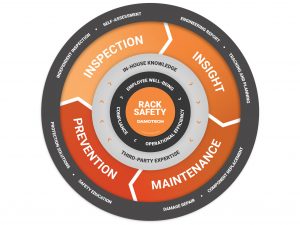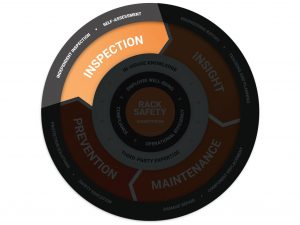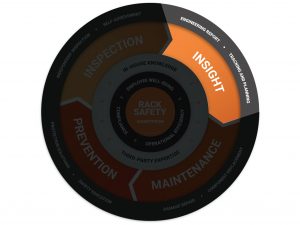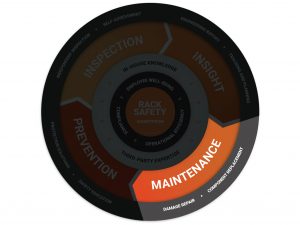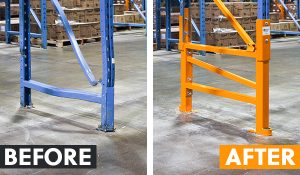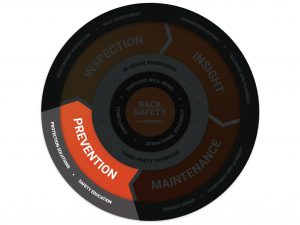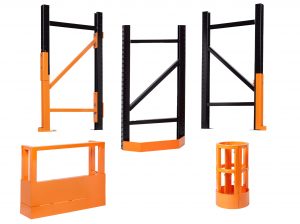Building an Effective Rack Safety Program for Warehouses
Guest blog by MHI Member Company Damotech
As a warehouse manager, safety is paramount for your employees, visitors, products, and equipment. Neglecting rack safety can lead to severe consequences, including injuries, property damage, and operational disruptions.
On the other hand, a robust rack safety program can positively impact the bottom line, prevent accidents, and reduce costs. This blog explores essential factors and best practices for enhancing rack safety and minimizing risks.
Rack Damage and Its Impact
Overlooking rack safety can have severe consequences, including injuries, property damage, and financial losses. The repercussions include inventory loss, increased expenses for rack repairs, downtime, reduced employee morale, operational inefficiencies, and damage to a company’s reputation and customer relationships.
Prioritizing rack safety is essential to mitigate these risks and maintain a successful warehouse operation.
Advantages of a Rack Safety Program
Prioritizing rack safety positively impacts a company’s bottom line by:
· Focusing on employee well-being by safeguarding them
· Improving operational efficiency by reducing downtime caused by damaged racks
· Showcasing the company’s compliance with national and local regulations
A comprehensive rack safety program ensures operational efficiency, regulation compliance, and substantial cost savings. Companies can establish a secure and efficient warehouse environment by safeguarding employees, equipment, and products.
The Rack Safety Program Blueprint and Its Benefits
A rack safety program blueprint, exemplified by the Rack Safety Flywheel, provides a clear roadmap to avoid risks and uncertainties when implementing safety measures. The Flywheel divides the safety process into four quadrants, and as effort is invested in each section, momentum is gained, enhancing warehouse and rack safety. Implementing this model fosters sustainable growth and success by focusing on essential areas and generating continuous progress.
Leveraging In-House and Third-Party Rack Safety Expertise
While attempting to implement a rack safety program alone can be challenging and less successful, seeking help from a third party can streamline the process and provide access to specialized expertise. Combining in-house knowledge with external expertise ensures a comprehensive and effective safety program that follows best practices. Utilizing third-party expertise ensures compliance with safety standards and provides practical solutions cost-effectively.
The Key Components of an Effective Rack Safety Program
A comprehensive rack safety program consists of four main areas, and it is an ongoing process without a definitive start or end. Continuous effort and maintenance are essential to ensure a safe warehouse environment.
Inspect Your Pallet Racks
Inspection is a crucial part of a comprehensive rack safety program, ensuring the well-being of employees and compliance with regulations. Routine inspections by warehouse staff or experts and yearly compliance inspections by third-party rack specialists are advised. It is recommended to involve rack engineers in compliance audits due to their expertise in rack safety and commitment to industry standards.
Gain Valuable Insights from Rack Inspection
Engineering reports provide technical insights, including repair recommendations and prioritizing corrective actions. Tracking and planning tools, like rack inspection and maintenance software, help convert insights into actionable steps, facilitating progress monitoring and KPI tracking.
Maintain Your Racks
Maintenance is crucial in upholding warehouse safety. Rack experts offer practical solutions and recommendations to tackle reported issues, such as component replacement and damage repair, reducing the risk of accidents and damages, minimizing maintenance expenses, and prolonging rack lifespan.
Rack repairs can be a surprising solution for damaged upright columns and braces in warehouse racks. Repairing damaged racks offers several advantages, including restoring load capacity, saving costs and time, minimizing disruptions to warehouse operations, reducing steel waste, extending rack lifespan, and safeguarding structural integrity.
Prevent Rack Damage and Safety Issues
Maintaining warehouse rack safety and reliability requires proactive measures to prevent damage and ensure smooth operations. Including protection solutions in the rack safety program can lower the risk of incidents and extend the rack lifespan. Safety education and employee training are essential to identify hazards and respond effectively to ensure a safe working environment and mitigate potential risks.
Leveraging Expertise: Implementing and Sustaining an Effective Rack Safety Program
Implementing and maintaining an effective warehouse rack safety program comes with challenges, including assessing hazards, implementing safety measures, and staying updated with regulations. Engaging the help of experienced warehouse safety experts can overcome these hurdles by:
• Offering engineering expertise
• Identifying overlooked hazards
• Assessing specific needs
• Providing fresh perspectives
• Guiding operators and workers
• Ensuring compliance
• Creating customized strategic programs
• Offering ongoing support
• Proposing tailored solutions
Leveraging their expertise helps companies establish a robust safety program that ensures regulatory compliance and protects employees and assets.






